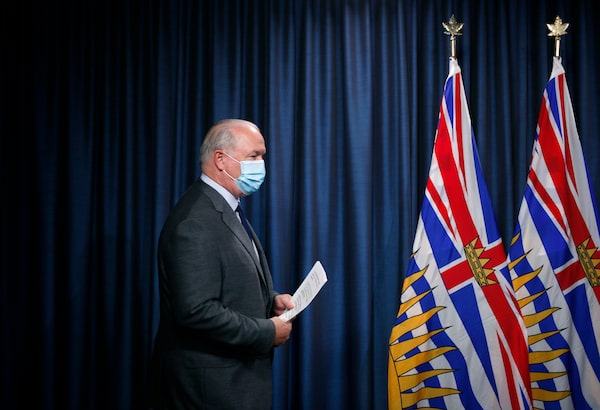
B.C. Premier John Horgan arrives to a press conference at Legislature in Victoria on Sept. 9, 2020.CHAD HIPOLITO/The Canadian Press
On Monday, British Columbia’s NDP government will lay out its agenda for the coming legislative session. After more than a year of reacting to the daily challenges of the pandemic, the Speech from the Throne is expected to offer a look ahead, not just to the coming months, but to years of rebuilding.
There is still much uncertainty ahead, but infrastructure investment is, in almost any scenario, going to be a pillar of the long-term plan.
The province’s financial picture is not pretty. Last year’s proposed surplus budget was swamped with emergency spending and undercut by lost revenues. The budget is now forecast to wind up as a $13-billion deficit. And the pressure on spending – especially on health care – will continue into the year ahead.
New Democrats reconvene as hiccups, frustrations plague national policy convention
But below the surface, the foundations are good. The province has, so far, retained its triple-A credit rating. After the initial lockdown last spring, B.C. has added jobs for 11 consecutive months, and employment levels are higher now than they were before the pandemic hit. Retail sales are robust, the housing market is buoyant and commodity exports are strong.
Economist Jock Finlayson, senior adviser to the Business Council of B.C., said the province is well positioned for recovery – in no small part thanks to the federal government. “B.C. has relied heavily on Ottawa’s balance sheet to get through the crisis. That’s a sensible strategy,” he said. The business council estimates that the federal government’s economic and social support measures have injected at least $25-billion into the B.C. economy since the pandemic started, with billions more to come. By comparison, the provincial government has committed roughly $7-billion to COVID-19 spending and tax deferrals.
Mr. Finlayson expects this year’s deficit to be much smaller than forecast, and modest economic growth in the year to come. “A deficit closer to $10-billion for 2020-21 is quite conceivable, in my view.”
So the provincial government can argue that it has room to take on new projects to help fuel the recovery. Traditionally, new infrastructure investments have focused on roads and bridges, hospitals and schools. But this round of stimulus spending might look different. At least it should.
Investments in life sciences, it now is clear, are needed to better prepare for the next pandemic. And job creation initiatives should be thoughtful about just who is meant to benefit: Employment inequities have also been exposed as younger workers, racialized employees and women in the workforce paid a higher price for last year’s economic downturn.
If it is traditional bricks-and-mortar infrastructure that the governments want, it should look at the one segment of public health that has long been neglected: long-term care facilities.
Seniors in care homes are vulnerable to COVID-19 because they live in close quarters, putting them at increased risk of infection. Those living conditions compound the fact that the elderly and those with underlying medical conditions are more likely to die or experience serious illness because of the virus.
For the past year, the province has focused on staffing and infection control in long-term care facilities. It enacted a single-site order that provided workers in care homes job security without having to juggle shifts at different facilities, and full sick pay benefits so they could afford to stay home when feeling ill. Those measures were needed.
But Health Minister Adrian Dix, long before the pandemic claimed the lives of hundreds of B.C. seniors in care, was aware that the system of long-term care was vulnerable. Over the span of decades, the provincial government has come to rely on the for-profit sector to deliver long-term care in British Columbia because it was cheaper to let the private sector meet the growing demand for more beds. And it did not invest in maintaining its own publicly funded facilities.
No matter whether the homes were run by the public or private sector, this underfunded, understaffed system, running at capacity, was not well-equipped to protect its residents when the pandemic arrived.
Before last year’s budget, before COVID-19, Mr. Dix said his government needed to invest in its publicly funded long-term care facilities because they are aging and in need of repair.
“There needs to be a major capital investment,” he said more than one year ago.
The pandemic has proved him right, and this is the time to make that happen. It would be unconscionable to neglect this needed investment any longer.
We have a weekly Western Canada newsletter written by our B.C. and Alberta bureau chiefs, providing a comprehensive package of the news you need to know about the region and its place in the issues facing Canada. Sign up today.
 Justine Hunter
Justine Hunter